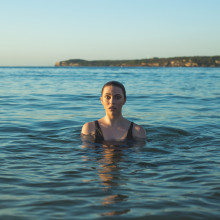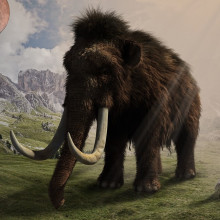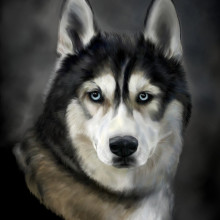The Genes Who Came in for the Cold
How do we cope at the extremes of low temperature? Across the world, groups of people have historically made their home in icy and inhospitable landscapes... and even today, groups of thrill seekers push their bodies to the limits by going swimming in water close to freezing. In this month's programme, genes that help us handle - and even enjoy - being very cold. We’ve got two stories from the ancient ice, including the oldest ever DNA; plus, two modern genes found to be helping us out in interesting ways, whenever things get particularly chilly...
In this episode

01:36 - Cold water swimming: the thrill of the chill
Cold water swimming: the thrill of the chill
Anna Ploszajski, Materials Scientist
As well as being a materials scientist, Anna Ploszajski is a cold water swimmer; she enjoys a regular dip in lakes and oceans that come close to freezing. And she's not alone - there are whole communities of such adventurers, who readily test their body's resilience to extreme temperatures. How do you become a cold water swimmer? Anna told Phil Sansom...
Anna - I live in central London and so for me, it's all about kind of reconnecting with nature, if that doesn't sound too hippie-ish! In the open water quite often it's just you, and so all you can hear is the sound of your arms making the bubbles as you do the strokes, and your own breathing; you can hear the birds around you... it's a very, very different environment for swimming.
Phil - It's maybe a stupid question, but it must get really cold, right?
Anna - It can get pretty chilly, yep, especially here in the UK.
Phil - Down to what, do you think?
Anna - The coldest I've been in is about one and a half degrees, which was in a small tarn halfway up a mountain in the Lake District.
Phil - Isn't that dangerous?
Anna - Yes. It would be dangerous if you went about it in the wrong way, of course. The way to acclimatise for swimmers is to get in regularly and get in while it is getting colder throughout the year, so while the autumn and the winter is starting. To be honest, it never feels good... what I mean is it would always feel cold, it will always feel shocking, you'll always feel nervous beforehand, but it becomes easier to overcome those types of negative feelings the more you do it and the more you realise it is going to be okay.
Phil - So do you think you feel the cold less - or you're just used to feeling the cold, you know what to expect, and you can handle it better?
Anna - I would say both. So there's the psychological element of getting in and getting cold, and that's the learned stuff, but there is definitely an uncontrollable element that is purely physical. And that's the side that I think is where the climatisation really comes into its own. That is your body physically adapting to learning how to do this. The first few times you do it, it can be really quite upsetting!
Phil - Right, because if you put me in the sea, even on the hottest day at Brighton beach or something, I'd still probably do a little high-pitched scream and then I'd run out!
Anna - Do you know what? There's still a lot of high pitched screaming that goes on in the cold water swimming community. You're really not alone - it's quite a universal experience! Actually the impact comes after you get out again and the recovery stages. What's really dangerous is to have a hot shower as soon as you get out, or to jump into any kind of heated environment like a hot car. All of the blood at the surface of your skin is still at one and a half degrees; if the body suddenly thinks that it's warm then it will start circulating that blood very quickly, which means that you're getting very, very cold blood going straight to your core, and that is when hypothermia can really set in. And that can drop blood pressure and do all sorts of nasty things. So at the lido that I swim in North London, you quite often get people fainting in the showers because they've gone for a cold swim and then they've come out and their blood pressure has dropped.
Phil - Wow. If you do everything right, people take this to quite extremes, don't they? Because you hear about people swinging huge distances in actual ice water.
Anna - Yeah, absolutely. The phenomenon of the ice mile has become really popular in swimming circles recently - so that's swimming a mile in water that is under five degrees Celsius.

05:14 - TRPM8: gene variant helps feel the cold
TRPM8: gene variant helps feel the cold
Aida Andrés, University College London
Groups of people living in cold parts of the world have had thousands of years to adapt to the climate. And adapt seems to be what they’ve done! Among other genes, there’s one that seems to particularly make a difference . It’s called TRPM8, it’s part of controlling how you feel the cold, and research from UCL’s Aida Andrés seems to show that it’s helped us evolve to live in northern latitudes. Aida spoke to Phil Sansom...
Aida - We studied a gene that encodes for a cold receptor. And what we found is that this gene has helped humans adapt to living in parts of the world where it's cold.
Phil - So this is a receptor for the cold that's in our skin?
Aida - Yeah. So it's in the nerves and it will tell your brain that it's cold.
Phil - What's the gene called?
Aida - TRPM8.
Phil - TRPM8...
Aida - Yes. So what we see in this gene is that there's a genetic variant that shows really large frequency differences between people that live in different places in the world. And this is something that is really unusual.
Phil - So if I live in, for example, Finland, I have a much higher chance of having one version of the gene; and if I live in Saudi Arabia, I guess I have a much higher chance of the other version?
Aida - Yeah, that's exactly right.
Phil - Aida, this sounds like a big pattern! Why did no one notice this before?
Aida - I think one of the reasons is that: the really striking thing about this particular gene is that you have correlations with latitude, and you really have to go after this pattern in order to see it. And when we looked at the frequencies in a map - that is when we saw the correlation with latitude. Plus, there's something else that is very interesting about this gene, and it's that this variant is not in the gene itself. It's in the regulatory part of the gene - it changes how the gene is expressed.
Phil - So if you look specifically at the TRPM8 bit, you're going to miss this change, because it's actually slightly further up the genome in the bit that's controlling which genes get actually turned into real, useful stuff?
Aida - That is correct. So the protein itself shows no differences between people in different populations. And what you have is this bit that is right before the gene, and that affects how it is expressed.
Phil - Okay, if I live somewhere northern, does my version of how this gene works - does it make me more sensitive to the cold, or less? Because I would think less, right?
Aida - So if your ancestors are from very high latitudes, you have most likely higher sensitivity to cold, actually.
Phil - I sense the cold more!
Aida - You do.
Phil - Why?
Aida - I know! I have to say, this is not very, very strong evidence, so the studies are small. But if the current studies are confirmed, I think that what tells you is that if you live in Finland... well, maybe it matters really very much if it's starting to get cold, that you notice that that's the case, and then your body can adapt, and maybe your behaviour even can adapt.
Phil - You're saying it's possible that because it's so important that we sense the cold - I mean, we don't want to die of cold - that if your ancestors came from your wintry place, then they need to be able to sense the cold really well so that they can go inside and put a fur on or something?
Aida - That's exactly right. I think that it's possible what they are telling us is that something that was not a very strong, selective pressure in some parts of the world, became a very strong, selective pressure. You really need to be able to feel the cold coming, and then you adapt to that.
Phil - Does that fit with our kind of colloquial myths of someone from a hot country coming to, I don't know, to Scotland and going, "oh my God, it's so cold here. How do you stand it?"
Aida - I think that what is happening here is that we're talking specifically only about genetic changes, right? Then on top of that, you have all of the physiological adaptations to cold temperature that people have through their lifetime. That's why we can move from one place to another and adapt also - because we're all so flexible.

09:38 - ACTN3: why some people shiver better
ACTN3: why some people shiver better
Victoria Wyckelsma, Karolinska Institute
Biologists have recently discovered why some people don’t gasp and shiver in the cold as much as others: a small genetic change in a gene called ACTN3 means they’re missing a crucial protein, which in turn makes their muscles better adapted for frosty weather. And this change is much more common in people who live in colder parts of the world - suggesting it evolved to help us deal with the climate. Phil Sansom spoke to Victoria Wyckelsma, a researcher at Finland’s Karolinska Institute...
Victoria - There's about 20% of people who lack this protein which is called alpha-actinin-3. And when we put these guys, about 40 men, in cold water, they had this amazing ability to maintain their temperature at a certain level.
Phil - Is that - about a fifth of people are extra-special-good at handling the cold?
Victoria - Yeah, it seems like it. So the guys who have this mutation - 70% of them could actually finish the cold challenge, so they could last the whole two hours no problem in the cold. And only about 30% of the guys with the protein could last.
Phil - I mean, I want to ask you about the biology, but first why on earth did these 40 people agree to sit in a really cold bath or something for an hour?
Victoria - It's a very good question. I think now actually it's quite topical, and it's quite popular to go swimming in such cold water. I mean, I know in Scandinavia, it's quite a new trend; I have an Australian friend who's moved to Sweden and she loves it, she's always in icy cold water. I guess they wanted to test themselves! And they weren't in for 3 hours or 2 hours straight; what we did was we put them in for 20 minutes, and then they're allowed out for 10 minutes. Then we put them back in, then we took them out. So they repeated that.
Phil - How did you connect this ability with a gene and a protein?
Victoria - It's been known for a while that there's this mutation that happens when people lack this gene. And one of the hypotheses was maybe these people have a higher tolerance to cold because they're more found in colder climates, and so we wanted to test this. And so all we had to do was take a blood sample and then we sent it to a lab. And then from that, they were able to tell us if this person was deficient in the gene, or they did have the gene.
Phil - Is the gene called alpha-actinin-3, just like the protein?
Victoria - Good question, we call it the ACTN3. So yeah, I mean, basically, yeah.
Phil - Okay, so what's going on?
Victoria - What's going on is the actinin-3 protein is actually a structural protein, and it sits within your muscle fibres; it's highly expressed in your fast muscle fibres. So you have fast muscle fibres, which help you in like athletic events such as sprinting; and then you have slow muscle fibres, which are good for endurance, so marathon running and things like that.
Phil - And where are my fast muscle fibres and where my slow ones, if I look at my body?
Victoria - They're in all your muscles.
Phil - Oh, okay.
Victoria - Your muscles are made up of a mix, and depending on which muscle group... so in the thigh muscle, you're meant to have about a 50:50 mix. So if you don't have alpha-actinin-3, your muscle acts more like a slow muscle, so you may have more of these slow fibres and they're bigger; whereas your fast fibres are actually smaller.
Phil - So alpha-actinin-3 makes the fast stuff, and when you lose it, it's less fast. Your muscles have more slow twitch; they're more of the slow type.
Victoria - Well, your muscle is far slower, we would say.
Phil - How does that help me stand the cold though?
Victoria - What happens is when you're put in a cold environment, your muscles will generate body heat for you. And one way they can do that is by shivering, and shivering is quite common in a fast muscle fibre type, but this also takes a lot of energy and it's quite exhausting, and your muscles fatigue much more quickly. And we actually associated that with the population who do have this protein. Whereas the population who are lacking this protein, they undergo more of like a low level muscle contraction to be able to generate body heat.
Phil - That seems so counterintuitive - that the standard type of shivering that you get with your fast twitch fibres is actually hindering these people in the cold.
Victoria - Yeah, absolutely. I mean, that was our main conclusion, that how we thought this was influencing these guys' ability just to stay in the cold bath for longer.
Phil - So has this been something that's really useful for people across the world that have gone up into the north, into the nouth, into colder parts of the land?
Victoria - Yeah, so they think the prevalence of this gene is far higher in areas where it's a cold climate. And they think it's more of a survival mechanism back in days before we had really nice warm apartments, and we had a large amount of food always available. The guys who were more likely to survive didn't need to make as much energy to survive and to keep themselves warm.
Phil - But then if I lived somewhere hot, is it helpful to me to have alpha-actinin-3?
Victoria - We don't know, actually. And that's probably one of the next things that we'll look towards is - what the advantages? Because apart from being a really good sprinter, we don't actually know what the positive benefits are from this.
Phil - Is there any way for me to tell if I have alpha-actinin-3?
Victoria - You could come to our lab in Sweden, have a muscle biopsy, and I could look at it for you. Or I think it's quite easy if you wanted to have a blood sample...
Phil - But there's no way you could tell from me just being... okay, so I've never been a good sprinter. I'm also not a great long distance runner! Is there any way that you could tell from what I'm like as a person? Or are there too many other factors?
Victoria - No, there's too many other other factors I think.
Phil - Okay!
Victoria - I actually have no idea because I am a terrible sprinter but I hate the cold. I don't know if that is because I am Australian and that contributes!

16:60 - Million year old mammoth DNA breaks record
Million year old mammoth DNA breaks record
Love Dalén, Centre for Palaeogenetics
Scientists have just broken the record for oldest DNA ever sequenced - using some mammoth teeth that are over a million years old. That’s so long, in fact, that the DNA inside has mostly broken down into tiny scraps, many of which are indistinguishable now as being from a mammoth. But thanks to some amazing techniques, Love Dalénand his colleagues have not only pieced the scraps together, but also uncovered part of the mammoth family tree, as well as some hints about when they got their woolly fur. Love told Phil Sansom the story...
Love - We managed to recover DNA from three mammoth specimens that are more than 1 million years old. And this is the oldest DNA ever recovered.
Phil - That isn't just the oldest DNA, right? That's by far the oldest DNA!
Love - This is by far the oldest DNA recovered to date. The previous record, if you wish, was approximately 650,000 years old. So we are nearly doubling that record with these mammoths.
Phil - What were the samples in this case?
Love - The samples were teeth - molar teeth - from three different mammoths from three different localities in Siberia. These specimens were actually found in the 1970s by a Russian palaeontologist named Andrei Sher. It actually took until 2017 until we felt that we had the technology and the know-how to do this. We had to use very new methods to identify which of all these billions of short DNA sequences we generated actually came from mammoth.
Phil - And what did you find inside? Because you said that the DNA... you had it in very short pieces?
Love - What we see in the data, once we get it, is the DNA is degraded into extremely small fragments. Normally a chromosome is well above 100 million base pairs or letters long, but in this case, our DNA sequences are on average between 40 and 50 base pairs long. So basically the genome is broken down into many, many millions of small pieces. And we also see that the vast, vast majority of DNA in these samples are not from mammoth; they are instead from bacteria; there is also DNA from plants in the sediments; and there's DNA from humans. Imagine that you have a puzzle with millions or even billions of small pieces that you have to piece together, and all we have to go by is the cover of the box. And in our case, that is the African elephant reference genome. But the problem here is that we don't only have one puzzle; instead, we actually have maybe 10 different puzzles, where the pieces have been mixed together. And the challenge here is to find the pieces that only belong to one of those puzzles, and then put them together in the right order.
Phil - Did you manage it though? Did you get the full jigsaw puzzle made for each of these three teeth?
Love - Yes and no. We managed to put together the puzzles as well as could possibly be done, but only for one of these mammoths do we have all the pieces in the puzzle. For the other two, we have partial genomes, but from a sort of population genomic perspective, that doesn't really matter; what matters is that we have enough data from each individual so that we can say something about their population history and relationship to other mammoths.
Phil - Right, so were they all very different kinds of mammoths?
Love - Well, one of them to our surprise came from a previously unknown type of mammoth that we didn't know existed. We refer to it as the Krestovka lineage.
Phil - Krestovka?
Love - Yes. The second specimen was actually what we expected to find; our expectation was that this one would be the ancestor of all wooly mammoths, and indeed that's what we find. And the third specimen is also interesting because it's a bit younger, it's about 700,000 years old, and this is actually one of the first known woolly mammoths.
Phil - Do you have any idea what this lost group of mammoths would've looked like?
Love - No, we didn't get enough genomic data to actually say anything about the sort of physical appearance about the Krestovka mammoth. We did get enough data from the other million year old mammoth, that was the ancestor of the woolly mammoth. This one is likely what we refer to as the steppe mammoth. Before this study it has been a bit unknown what they look like, because what we have are bones and teeth and so on from them, and tusks. So we knew they were big - they were much bigger than wooly mammoths - but what we now can see is that they actually appear to have had nearly all of these cold adaptations that we also see in woolly mammoths. They had woolly fur, adaptations for thermoregulation, and they probably also had this gene variant that made them slightly less sensitive to cold temperatures, which we also see in woolly mammoth.
Phil - I keep going back to the 1 million years old figure. Are we going to keep seeing these dates go further and further back? Or is that it, call it a day, 1 million - we're done!
Love - I don't think we're done at all. I mean, we can see in the data that the specimens are close to the limit, but they are not at the limit. So we know based on this data that we can go further back in time. The question is how far. These theoretical models basically say that there is no DNA at all left, the limit there is something like 7 million years. But at that limit the DNA is going to be broken down into very small fragments, like a few base pairs, and we can't work with that, because you can't prove that it comes from the animal in question. So the real question is: how far back in time can we go, and still be able to identify these fragments as being from mammoth or whatever animal we analyse? I think we can go beyond 2 million.

23:04 - The 10,000-year-old bone and the first dogs in America
The 10,000-year-old bone and the first dogs in America
Charlotte Lindqvist, University at Buffalo
Scientists have sequenced the genes of the oldest known dog in the Americas. Its only remains are a 10,000-year-old scrap of bone, but by comparing its DNA to its closest Siberian relatives, they’ve been able to figure out roughly when its ancestors split and moved into the Americas - and interestingly, this date corresponds with when we think humans did the same.
This story actually began in the 90s, when geologist Timothy Heaton excavated an Alaskan cave, and uncovered piles of bone fragments. He brought them back to the University of South Dakota, and spent decades sifting through them, alongside a number of collaborators that include the University at Buffalo's Charlotte Lindqvist. Charlotte told Phil Sansom there was one, unassuming, little piece of skeleton that ended up being more that it seemed…
Charlotte - This particularly tiny bone here we weren't sure of. We knew it must have come from a mammal, and we thought it could be a bear because there were all these other bear bones in this cave. We got the DNA from it, and then we discovered this doesn't really look like bear DNA. And then comparing it to just a large database of DNA sequence data we could see that it matched best to dog or potentially wolf, because dogs and wolves are closely related. And that was not what we were expecting, I mean, from all the bones that we have analysed from these caves, we have never before come across a dog. And of course a dog is quite spectacular, because we know if there was a dog, there must have been humans.
Phil - Right, because dog is the version of wolf that we've domesticated, so if you find it's dog and not wolf, humans must have been around?
Charlotte - Exactly, yes.
Phil - How old was this dog?
Charlotte - It's actually the oldest bone in this cave. It's around 10,000 years old. Actually it is then among the oldest domesticated dogs from the New World that we have confirmed.
Phil - Is New World... is that the Americas?
Charlotte - Yes.
Phil - Wow, a 10,000 year old dog bone. It must have been in pretty bad condition after so long. How much of the DNA, then, did you end up piecing together?
Charlotte - What we focused on, and have focused on so far, is the mitochondrial DNA. But we were able to... the DNA was fairly well preserved, and we were able to put together an entire mitochondrial genome from this little bone.
Phil - Does that then tell you sort of where this dog came from - a bit about its family tree?
Charlotte - Yeah. So then when we have this mitochondrial genome sequence, we can compare that with dogs from the New World, modern dogs, and what we have available of other ancient dogs, of wolves, and including ancient dogs that have been found in the Americas. And we've found that our ancient 10,000 year old dog from Alaska was a close relative of these dogs. So it sort of suggested to us that it must be a descendant of a very early or extinct lineage. It came from Siberia, like humans did, moved along the coast and into the rest of the Americas south of the ice sheets.
Phil - You're saying that this dog might've been kind of the puppy, of the puppy, of the puppy, of the first dog in America?
Charlotte - Something like that!
Phil - Oh my god!
Charlotte - They probably diverged from these Siberian dogs more than 16,000 years ago.
Phil - You already talked about how they're really closely linked with humans. So do you know what humans they would have come with?
Charlotte - It's fairly clear... and we can see that too from the diet of this dog that it had a largely marine diet. And dogs are not very good marine mammal hunters or fishers, so it must have eaten food that humans gave it. So this dog must have been with humans, right. We also do have human artefacts and actually human remains from this area, even from around this time around 10,000 years ago. From genetic data as well we have estimates that these native indigenous people that moved into America split from their Siberian ancestors around the same time as the date that we find for these dogs. So it strongly suggests that the first people that moved into the Americas brought their dogs with them.
Phil - That's wild. The very first people?
Charlotte - The very first people and the very first dogs.
Phil - What should I be picturing? Were these people coming through Siberia and over into Alaska with chihuahuas, or what?
Charlotte - All these modern dog breeds that we know of today, everything from chihuahuas to great Danes, are really only a few hundred years old. I think you would probably more like imagine something like a malamute or a sled dog, something maybe looking a little more closer to a wolf.










Comments
Add a comment